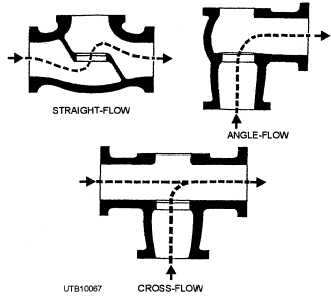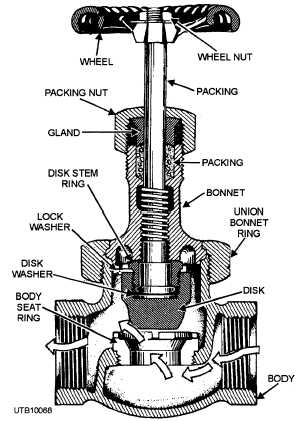upward when the valve is opened. In some rising stem valves, the stem projects above the handwheel when the valve is opened. The purpose of the rising stem is to allow the operator to see whether the valve is opened or closed.
GLOBE VALVE
The name is derived from the globular shape of the valves; however, other types of valves may also have globe-shaped bodies, so do not jump to the conclusion that a valve with a globe-shaped body is actually a globe valve. The internal structure of a valve, not the external shape, is what distinguishes one type of valve from another.
In a globe type of stop valve, the disk is attached to the valve stem. The disk seats against a seating ring or a seating surface that shuts off the flow of fluid. When the disk is removed from the seating surface, fluid can pass through the valve in either direction. Globe valves may be used partially open as well as fully open or fully closed.
The fluid flow is proportionate to the number of turns of the wheel in opening or closing the globe valve. The globe valve is ideal for service that requires frequent valve settings (throttling).
Globe valve inlet and outlet openings are arranged in several ways to satisfy different requirements of flow.
Figure 4-2 shows three common types of globe valve bodies. In the straight type, the fluid inlet and outlet openings are in line with each other. In the angle

Figure 4-2. - Types of globe valve bodies.
type, the inlet and outlet openings are at an angle to each other. An angle type of globe valve is commonly used where a stop valve is needed at a 90-degree turn in a line. The cross type of globe valve has three openings, rather than two; it is frequently used in connection with bypass lines.
Globe valves are commonly used in steam, air, oil, and waterlines. In many boiler plants, there are surface blow valves, bottom blow valves, boiler stops, feed stop valves, and many guarding valves and line cutout valves. Globe valves are also used as stop valves on the suction side of many fireroom pumps as recirculating valves in the fuel oil system and as throttle valves on most fireroom auxiliary machinery. A cross-sectional view of a globe valve is shown in figure 4-3.
BUTTERFLY VALVE
The butterfly valve (fig. 4-4) in certain applications has some advantages over gate and globe valves. The butterfly valve is light in weight, takes up less space than a globe valve or gate valve, is easy to overhaul, and can be opened or closed quickly.
The design and construction of butterfly valves may vary, but a butterfly type of disk and some means of sealing are common to all butterfly valves.

Figure 4-3. - Globe valve.
Continue Reading